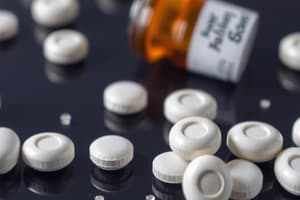Podcast
Questions and Answers
What does bioavailability refer to in pharmacology?
What does bioavailability refer to in pharmacology?
- The total amount of drug present in the body
- The fraction of an uncharged drug reaching systemic circulation (correct)
- The percentage of a drug eliminated by the liver
- The rate at which a drug is absorbed into the bloodstream
Which drug is known to prolong the duration of local anesthetics when injected with them?
Which drug is known to prolong the duration of local anesthetics when injected with them?
- Estrogen
- Adrenaline (correct)
- Magnesium sulfate
- Vohimbine
What is the primary effect of a drug typically referred to as?
What is the primary effect of a drug typically referred to as?
- Therapeutic effect (correct)
- Side effect
- Adverse effect
- Toxic effect
Which route of drug administration is most likely to cause the first-pass effect?
Which route of drug administration is most likely to cause the first-pass effect?
Which of the following defines a drug's half-life (t½)?
Which of the following defines a drug's half-life (t½)?
What type of antagonism occurs between adrenaline and histamine?
What type of antagonism occurs between adrenaline and histamine?
Which drug acts as a dual-acting adrenergic agent that can induce tachyphylaxis?
Which drug acts as a dual-acting adrenergic agent that can induce tachyphylaxis?
Which of the following drugs is considered cardio-selective and does not have pulmonary side effects?
Which of the following drugs is considered cardio-selective and does not have pulmonary side effects?
Study Notes
Pharmacokinetics
- Bioavailability: The fraction of an uncharged drug reaching the systemic circulation following any route administration.
- Therapeutic effect: The drug's primary effect.
- First-pass effect: More likely to occur with oral drug administration.
- Half-life (t½): The time required to reduce the amount of a drug in plasma by half during the elimination.
- Pharmacokinetics: The study of drug absorption, distribution, metabolism and excretion.
Adrenergic Pharmacology
- Estrogen: Liver microsomal enzyme inhibitor.
- Adrenaline: Catecholamine used for the prolongation of action of local anesthetics.
- Physiological antagonism: Exists between adrenaline and histamine.
- Magnesium sulfate: Produces qualitatively different actions when administered through various routes.
- Amphetamine: Indirectly enhances the release of catecholamines.
- Reserpine: Used for the treatment of hypertension through its inhibitory action on noradrenaline storage.
- Guanethidine: Used for the treatment of hypertension through its inhibitory action on noradrenaline release.
- Atenolol: Cardio-selective beta blocker with no pulmonary side effects, suitable for treating angina in asthmatic patients.
- Blood-brain barrier: Restricts the entry of many drugs into the brain and is constituted by P-glycoprotein efflux carriers in brain capillary cells.
- MAO & COMT: Enzymes that metabolize adrenaline.
Adrenergic Pharmacology cont.
- Ephedrine: Noncatecholamine dual-acting adrenergic drug which induces tachyphylaxis
- Phentolamine: Alpha-2 adrenergic receptor antagonist with aphrodisiac activities, induces orthostatic hypotension as a side effect.
- Vohimbine: Alpha-2 adrenergic receptor antagonist with aphrodisiac activities.
Studying That Suits You
Use AI to generate personalized quizzes and flashcards to suit your learning preferences.
Description
Test your knowledge on pharmacokinetics and adrenergic pharmacology through this quiz. Explore concepts such as bioavailability, therapeutic effects, and the first-pass effect, as well as the actions of various adrenergic drugs. Perfect for students of pharmacology and medicine!




